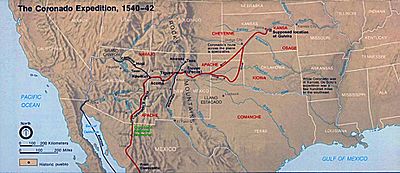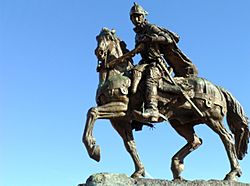Quivira facts for kids
Quivira was a place where the Wichita people lived a long time ago. It was located near the Great Bend of the Arkansas River in central Kansas. Today, the exact spot might be near Lyons and stretching northeast to Salina.
The Wichita city of Etzanoa, which was a busy place between 1450 and 1700, was probably part of Quivira.
A Spanish explorer named Francisco Vásquez de Coronado visited Quivira in 1541.
Contents
What Quivira Was Like
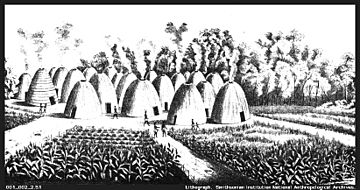
Scientists have found old remains that show Quivira was near the Great Bend of the Arkansas River in central Kansas. They found signs of several Native American villages near Lyons, along Cow Creek and the Little Arkansas River. They also found Spanish items from Coronado's time.
The people of Quivira were almost certainly the Wichita. What Coronado wrote about Quivira sounds a lot like later Wichita villages. There seemed to be many Quivirans, maybe at least 10,000 people, based on how many villages Coronado saw. They were good farmers and also hunted bison. Coronado described them as healthy and peaceful.
The land of Harahey, which Coronado found next to Quivira, might have been along the Smoky Hill River near Salina today.
The next European to visit this area after Coronado was Étienne de Bourgmont in 1724. He traveled with Kaw and other Native American explorers. They went west from the Missouri River to a large Native American village. This village was near Lyons, in the same area where Quivira had been almost 200 years earlier.
The original people of Quivira later moved to eastern Kansas and south into Oklahoma. They might have moved to get away from the Plains Apache people, whose expansion caused fighting among the groups on the Great Plains. Also, there seemed to be fewer Wichita people in the 1700s than in the 1500s. This was probably because of diseases like smallpox that came from Europe.
The Name "Quivira"
No one is completely sure where the name "Quivira" came from. The people Coronado met in Quivira called themselves "Tancoa" and "Tabas." These names are similar to the names of two Wichita tribes: the Tawakonis and Taovayas.
Coronado's Expedition
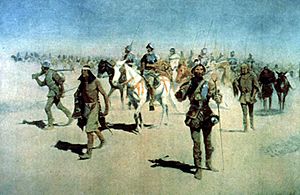
In 1540, a Spanish leader named Francisco Vásquez de Coronado led a big trip north from Mexico. He was looking for riches and the "Seven Cities of Cibola," which were rumored to be full of gold. Instead of gold, he found Native American farmers living in many villages in what is now Arizona and New Mexico. These were the Hopi, Zuni, Rio Grande Pueblo, Apache, and Navajo peoples.
When Coronado reached the Rio Grande, he was disappointed because the Pueblo people didn't have much gold. But then, a Native American guide, whom the Spanish called "The Turk," told him about a rich land called Quivira far to the east. The Turk said its leader drank from golden cups hanging from trees. Hearing this, Coronado led more than 1,000 Spanish and Native American people onto the Great Plains in 1541. The Turk was their guide.
On his journey, Coronado crossed the Llano Estacado, a flat area where two Native American groups, the Querecho and Teya, lived. Coronado was heading southeast when the Teyas told him that the Turk was leading them the wrong way. They said Quivira was to the north. It seems the Turk was trying to trick the Spanish by telling them stories of wealth in Quivira, hoping they would get lost on the huge Great Plains.
Coronado sent most of his slow-moving group back to New Mexico. He continued with 30 Spanish riders, some Native Americans, priests, the Turk, and some Teya captives. Coronado changed direction and rode north to find Quivira. After more than 30 days of travel, he found a large river, probably the Arkansas River. Soon after, he met some Native American bison hunters who guided him to Quivira.
The Spanish Visit Quivira
Coronado found Quivira "well settled." He said the land was "very fat and black" and had "many small rivers, springs, and rivers." He also found "plums like those in Spain, and nuts and very good sweet grapes and mulberries." He called it the best land he had seen on his long trip from Mexico.
Coronado stayed in Quivira for 25 days and traveled about 65 miles (25 leagues) from one end of the area to the other. He found only villages with straw-thatched houses, some with up to 200 homes. There were also fields of corn, beans, and squash. He found no gold, except for one small piece, which he thought the Native American owner had gotten from someone in his own group.
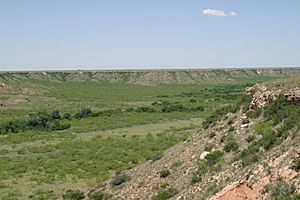
The Spanish described the local people as "large people of good build." Many of the men were over 6 feet (183 cm) tall, which seemed very tall to the Spanish. Both men and women wore very little clothing.
Coronado was taken to the edge of Quivira, to an area called Tabas, where the neighboring land of Harahey began. He asked to meet the "Lord of Harahey." The leader came with nearly 200 people to meet the Spanish. The Harahey group was "all naked — with bows and some sort of things on their heads, and their private parts slightly covered." Their land was similar in size and appearance to Quivira.
Coronado was disappointed because he didn't find any gold. He then turned back toward New Mexico, met the rest of his army, and returned to Mexico the next year. Before leaving Quivira, Coronado ordered "The Turk" to be executed. Coronado's trip had failed to find gold.
Coronado left some Catholic priests and their helpers in New Mexico, including Friar Juan de Padilla. Padilla traveled back to Quivira with a Portuguese helper and some Native Americans who had become Christians. The friar and most of his friends were soon killed by the people from Quivira. This happened because he wanted to leave their land to visit their enemies, the Guas. The Portuguese and Native American survivors told the story.
Later Expeditions
In 1594, Francisco Leyba (Leyva) Bonilla and Antonio de Humana (Umana) tried to find Coronado's Quivira again. Spanish officials said this trip was not allowed. Only one person, Jusepe Gutierrez, a Nahua, came back from this journey. He said that Leyba had killed Umana in a fight and that he (Jusepe) had left the group.
After this, in 1601, the governor of New Mexico, Juan de Oñate, led another trip to find Quivira. He found villages of the Escanjaque and Rayados in the Central Great Plains, but no gold or silver. He learned that Leyba and others from the earlier trip had been killed by Native Americans. In 1606, 800 people from Quivira reportedly visited Oñate in New Mexico to trade.
In 1634, Captain Alonzo Vaca said he found Quivira 300 leagues (more than 745 miles or 1200 km) east of New Mexico. Another trip was supposedly made in 1662 by Diego Dionisio de Penalosa, who claimed to find a large city. However, experts today think his story is not true.
Spanish records said the Quivirans were enemies of the Escanjaques. In 1675 and 1678, the Spanish king issued "two royal orders for the conquest of Quivira."
Quivira on Maps
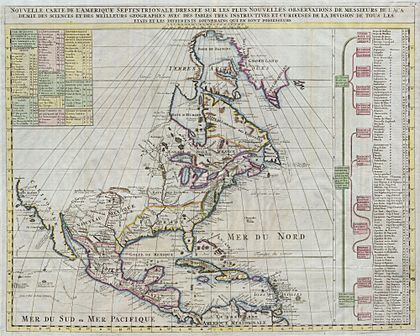
On early maps from the 1500s and 1600s, a large area of North America was called "Quivira." This area included parts of what are now Kansas, Oklahoma, southeastern Colorado, northeastern New Mexico, and the Texas Panhandle.
Quivira's Legacy Today
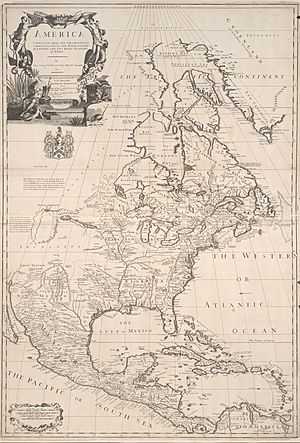
Today, the name Quivira is still used for the city of Lake Quivira and the Quivira National Wildlife Refuge in Kansas.
Also, the "Quivira Council" of the Boy Scouts serves the area of southwestern Kansas around Wichita. This is the central part of the area that was once called Quivira. The first yearbooks printed by the University of Kansas were named Quivira. There is also a major road in the Johnson County suburbs of Kansas City called "Quivira Road."
A large abandoned pueblo (an old Native American village) in Torrance County, New Mexico, was named "La Gran Quivira" ("the Great Quivira"). This village was in the land of the Tompiro-speaking Pueblo people. When the Spanish first arrived, a mission was built there. In the 1670s, the Tompiro villages were left empty, and their people joined other Pueblos. Today, the remains of Gran Quivira Pueblo and the mission are part of Salinas Pueblo Missions National Monument.
From the days of Coronado, the name "Quivira" was linked to the idea of a great, unknown city, full of wealth and beauty, somewhere on the Eastern Plains. It's likely that when people from the Rio Grande Valley crossed the mountains and wild lands to the east, looking for animals or gold, and suddenly saw a silent, empty city that showed signs of many people, great resources, and amazing building skills, they connected it to the stories they heard as children about a mythical center of riches and power, and called this new wonder the Gran Quivira.
See also
 In Spanish: Quivira para niños
In Spanish: Quivira para niños


